Performance of Three Sorghum Cultivars under Excessive Rainfall and Waterlogged Conditions in the Sudano-Sahelian Zone of West Africa: A Case Study at the Climate-Smart Village of Cinzana in Mali
Abstract
1. Introduction
2. Materials and Methods
2.1. Experimental Design
2.2. Site Conditions
2.3. Experimental Material
2.4. Moisture Treatment
2.5. Soil Analysis
2.6. Field Observations
3. Results
3.1. Distribution of Precipitation and Waterlogging
3.2. Sorghum Above-Ground Biomass Production and Yield
4. Discussion
4.1. Irrigation Effects
4.2. Waterlogging Effects
5. Conclusions
Author Contributions
Funding
Acknowledgments
Conflicts of Interest
References
- Biasutti, M. Forced Sahel rainfall trends in the CMIP5 archive. J. Geophys. Res. Atmos. 2013, 118, 1613–1623. [Google Scholar] [CrossRef]
- Intergovernmental Panel on Climate Change. Climate Change 2013. The Physical Science Basis Working Group I Contribution to the Fifth Assessment Report of the Intergovernmental Panel on Climate Change; Stocker, T., Ed.; Cambridge University Press: New York, NY, USA, 2014; ISBN 9781107661820. [Google Scholar]
- Intergovernmental Panel on Climate Change. Climate Change 2014. Impacts, Adaptation, and Vulnerability Working Group II Contribution to the Fifth Assessment Report of the Intergovernmental Panel on Climate Change; Field, C.B., Barros, V.R., Eds.; Cambridge University Press: New York, NY, USA, 2014; ISBN 1107058163. [Google Scholar]
- Cogato, A.; Meggio, F.; Migliorati, M.D.A.; Marinello, F. Extreme weather events in agriculture: A systematic review. Sustainability 2019, 11, 2547. [Google Scholar] [CrossRef]
- Magassa, M. Vers la Planification au Changement Climatique dans la Zone Soudanienne du Mali: Analyse de la Vulnérabilité au Changement Climatique des Ménages Agricoles; Mémoire de Master ISTOM: Angers, France, 2018. [Google Scholar]
- Alhassane, A.; Salack, S.; Ly, M.; Lona, I.; Traoré, S.B.; Sarr, B. Evolution of agro-climatic risks related to the recent trends of the rainfall regime over the Sudano-Sahelian region of West Africa. Sécheresse 2013, 24, 282–293. [Google Scholar] [CrossRef]
- Chaplowe, S.; Musori, M.; Daumer, E. Emergency Plan of Action (EPoA) Mali: Floods; IFRC: Bamako, Mali, 2020. [Google Scholar]
- Kaur, G.; Nelson, K.A.; Motavalli, P.P.; Singh, G. Adaptation to early-season soil waterlogging using different nitrogen fertilizer practices and corn hybrids. Agronomy 2020, 10, 378. [Google Scholar] [CrossRef]
- Daku, E.K. Assessment of Loss and Damage Induced by Waterlogging and Submergence Stress in Maize under Typical Ambient Conditions of the West African Sahel. Ph.D. Thesis, Université des Sciences, Bamako, Mali, 2020. [Google Scholar]
- Institut National de la Statistique. Analyse des Bilans Alimentaires du Mali sur la Période 2010–2015: Rapport Définitif; INSTAT: Bamako, Mali, 2019. [Google Scholar]
- Seebörger, U. Länderinformationsportal Mali. Available online: https://www.liportal.de/mali/ (accessed on 10 August 2020).
- Diabaté, I. Enquête Nationale Nutritionnelle Anthropométrique et de Mortalité Rétrospective Suivant la Méthodologi MSART-2019, Mali; INSTAT: Bamako, Mali, 2019. [Google Scholar]
- Maiti, R.K.; Bidinger, F.R. Growth and Development of the Pearl Millet Plant, Research Bulletin No. 6; ICRISAT: Patancheru, India, 1981. [Google Scholar]
- Institut National de la Statistique. Etude D’évaluation de la Qualité des Statistiques Agricoles et Propositions D’amélioration: Rapport 2019; INSTAT: Bamako, Mali, 2019. [Google Scholar]
- Matsuura, A.; An, P.; Murata, K.; Inanaga, S. Effect of pre- and post-heading waterlogging on growth and grain yield of four millets. Plant Prod. Sci. 2016, 19, 348–359. [Google Scholar] [CrossRef]
- Theriault, V.; Smale, M.; Assima, A. The Malian fertiliser value chain post-subsidy: An analysis of its structure and performance. Dev. Pract. 2018, 28, 242–256. [Google Scholar] [CrossRef]
- Food and Agriculture Organization. West African Catalogue of Plant Species and Varieties; FAO: Rome, Italy, 2008; ISBN 978-92-5-105965-4. [Google Scholar]
- Ahmad, N.; Kanwar, R.S. Effect of different Moisture stress levels on Corn Growth in Field Lysimeters. Trans. ASAE 1991, 34, 1991–1996. [Google Scholar] [CrossRef]
- Food and Agriculture Organization. Crop Information. Available online: http://www.fao.org/land-water/databases-and-software/crop-information (accessed on 10 August 2020).
- United States Agency for International Development. West African Fertilizer Recommendations; USAID: Washington, DC, USA, 2018.
- Mali Meteo. Climate Data 01/2018–03/2019 Segou Region; Mali Meteo: Bamako, Mali, 2019. [Google Scholar]
- Vaksmann, M.; (CIRAD, Bamako, Mali). Personal communication, 2019.
- Bakker, D. Waterlogging Factsheet; Departement of Agriculture and Food: South Perth, Australia, 2020.
- Ouedraogo, M.; Houessionon, P.; Zougmoré, R.B.; Partey, S.T. Uptake of Climate-Smart Agricultural Technologies and Practices: Actual and Potential Adoption Rates in the Climate-Smart Village Site of Mali. Sustainability 2019, 11, 4710. [Google Scholar] [CrossRef]
- Diallo, A.G.; Sory, S.; Touré, A.O.; Toure, F.; Touré, A. Agronomic Performances of Hybrid Sorghum bicolor [L] Moench, Guinea Races Cultivated under Limited and High-Soil Phosphorus Conditions. J. Plant Biol. Soil Health 2017, 4, 8. [Google Scholar]
- Dembélé, S. Developing Cultivation Practices to Combat Early Drought Challenges: The Case of Sorghum in Mali. Ph.D. Thesis, University of Cape Coast, Cape Coast, Ghana, 2016. [Google Scholar]
- Traoré, K.; Sidibé, D.K.; Coulibaly, H.; Bayala, J. Optimizing yield of improved varieties of millet and sorghum under highly variable rainfall conditions using contour ridges in Cinzana, Mali. Agric. Food Secur. 2017, 11, 13. [Google Scholar] [CrossRef]
- Zhang, F.; Zhu, K.; Wang, Y.Q.; Zhang, Z.P.; Lu, F.; Yu, H.Q.; Zou, J.Q. Changes in photosynthetic and chlorophyll fluorescence characteristics of sorghum under drought and waterlogging stress. Photosynthetica 2019, 57, 1156–1164. [Google Scholar] [CrossRef]
- Allen, R.G.; Pereira, L.S.; Raes, D.; Smith, M. Crop Evapotranspiration. In FAO Irrigation and Drainage Paper No. 56; FAO Irrigation and Drainage Paper No. 56; FAO: Rome, Italy, 1990. [Google Scholar]
- Farah, S.M.; Salih, A.A.; Taha, A.M.; Ali, Z.I.; Ali, I.A. Grain sorghum response to supplementary irrigations under post-rainy season conditions. Agric. Water Manag. 1997, 33, 31–41. [Google Scholar] [CrossRef]
- Clerget, B.; Sidibe, M.; Clavijo-Torres, F.; Chantereau, J.; Evrard, J.C.; Vidal, A.; Luce, C. Ecophysiologie du sorgho: Rapport de Campagne D’hivernage 2007; CIRAD/ICRISAT: Bamako, Mali, 2007. [Google Scholar]
- Promkhambut, A.; Younger, A.; Polthanee, A.; Akkasaeng, C. Morphological and Physiological Response of Sorghum (Sorghum bicolor L. Moench) to Waterlogging. Asian J. Plant Sci. 2010, 9, 183–193. [Google Scholar]
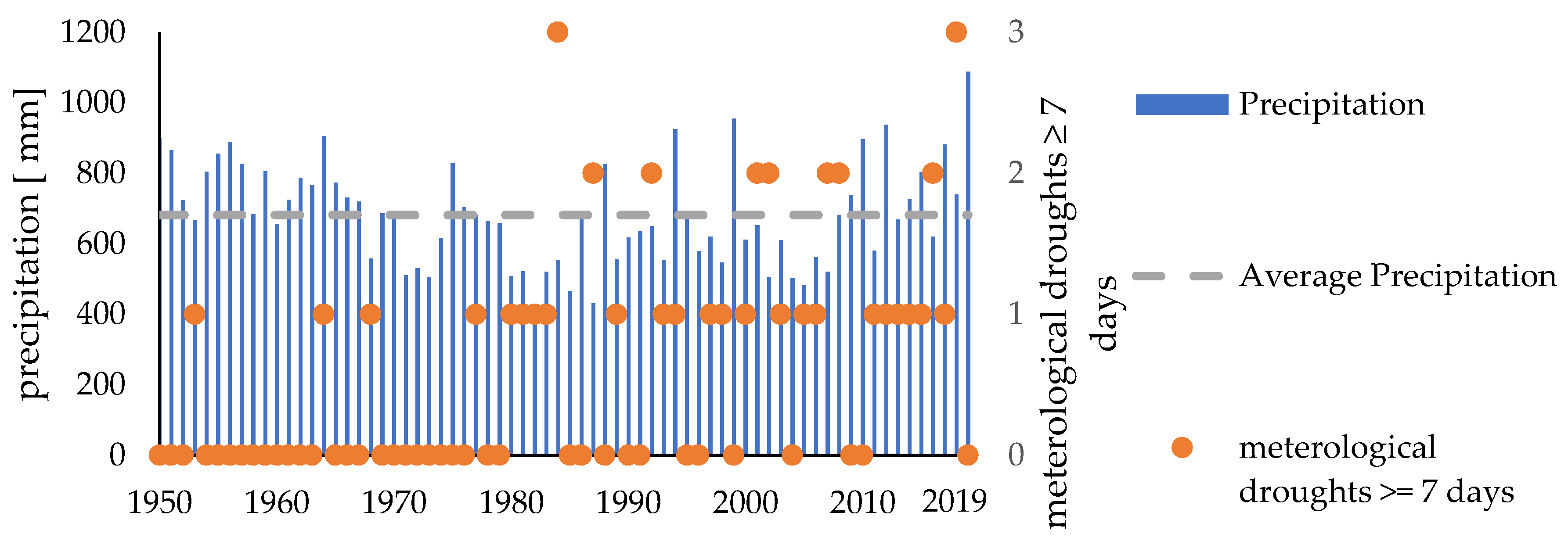
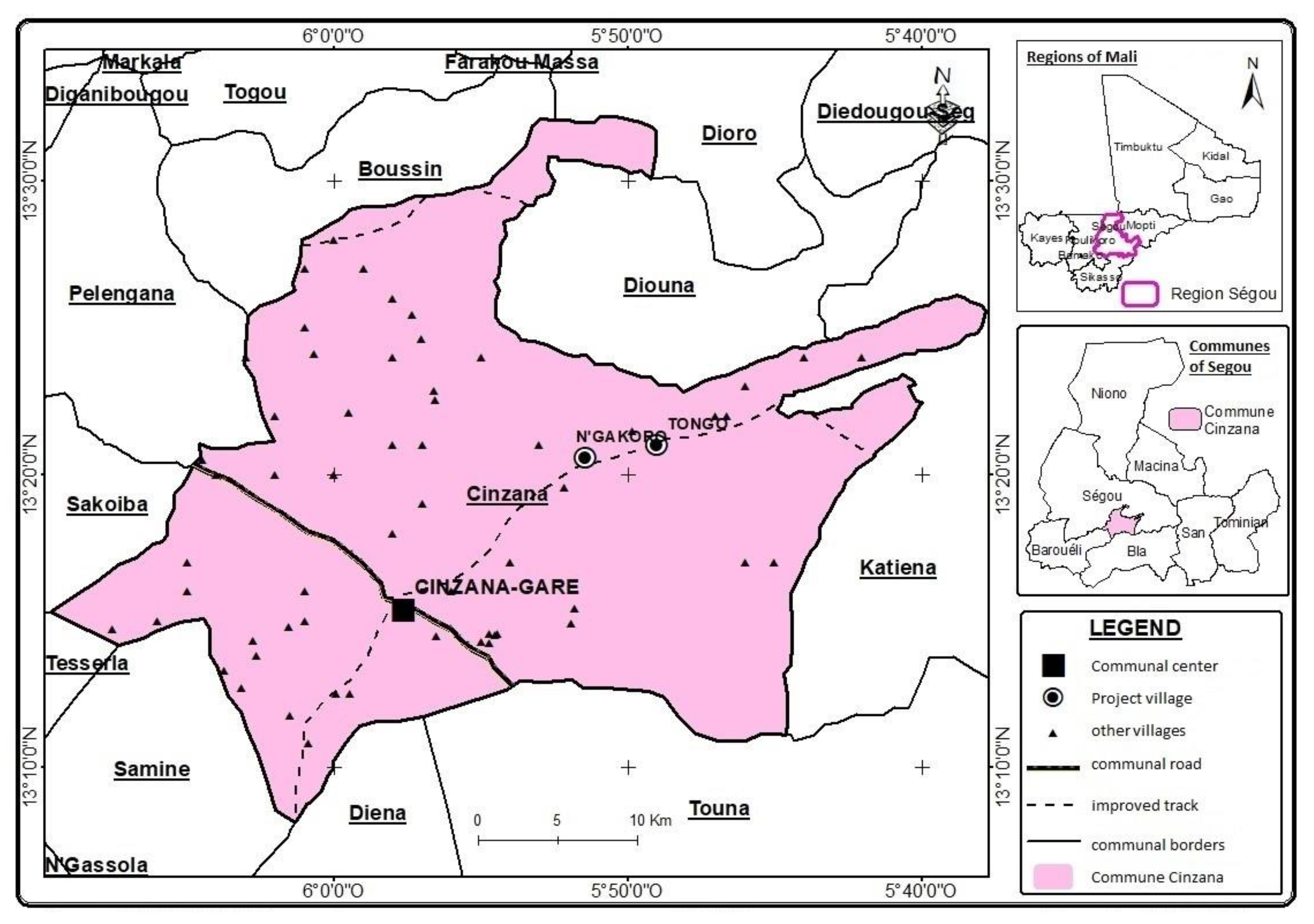
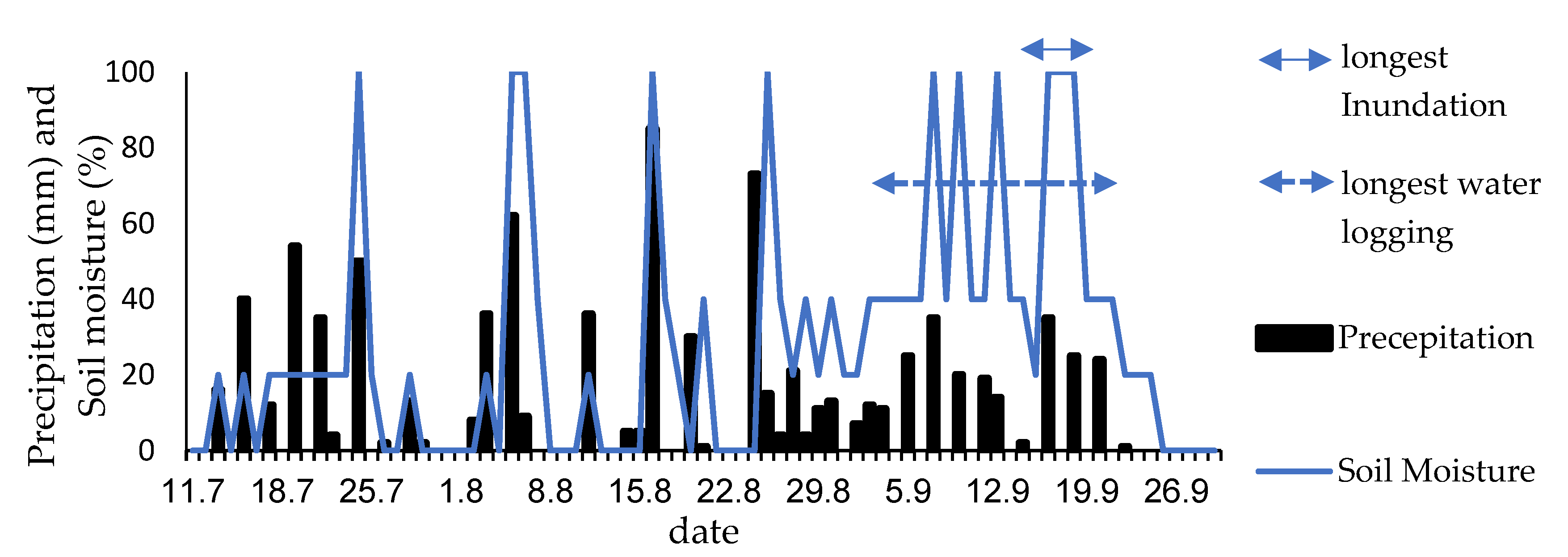
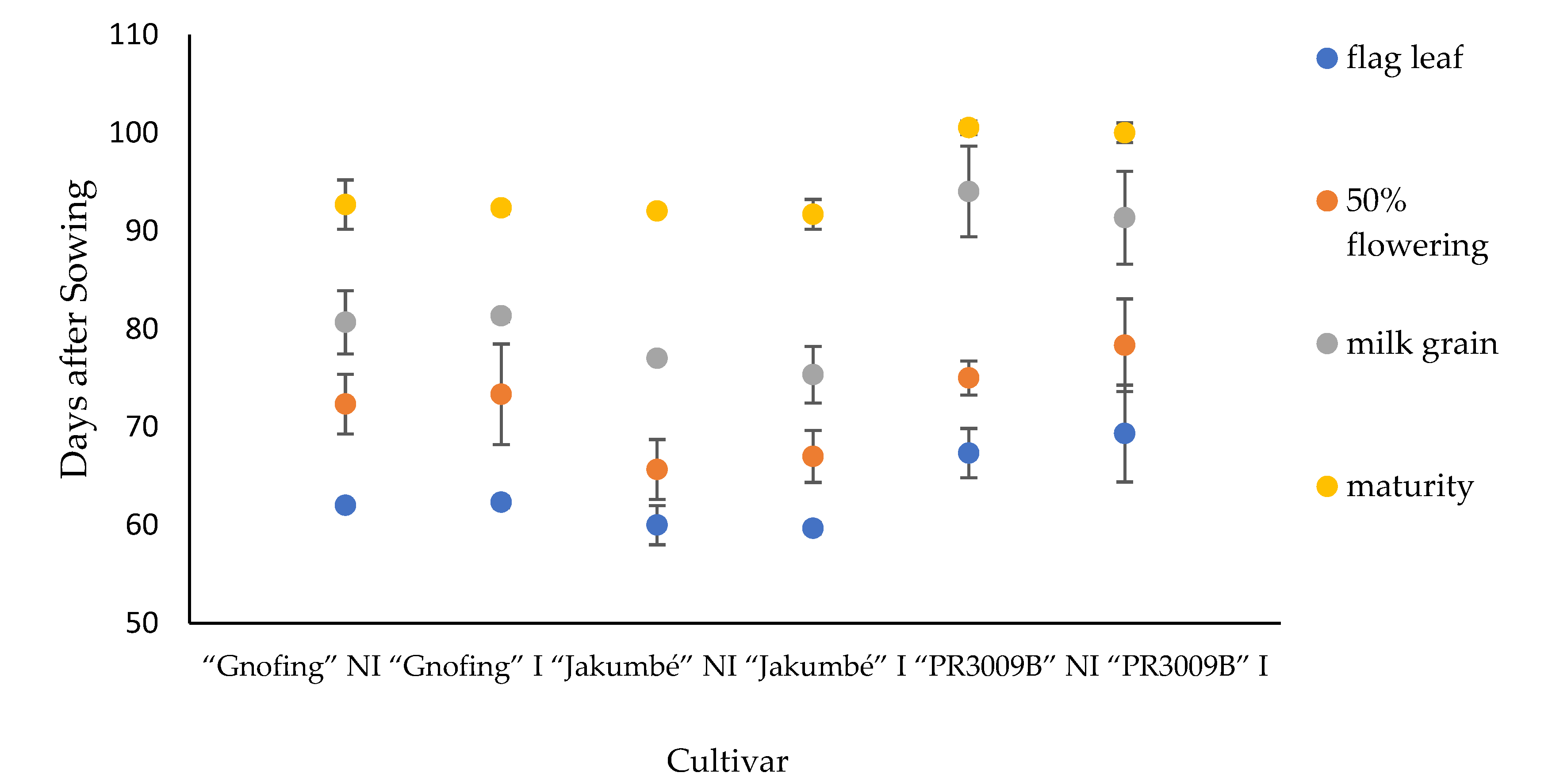
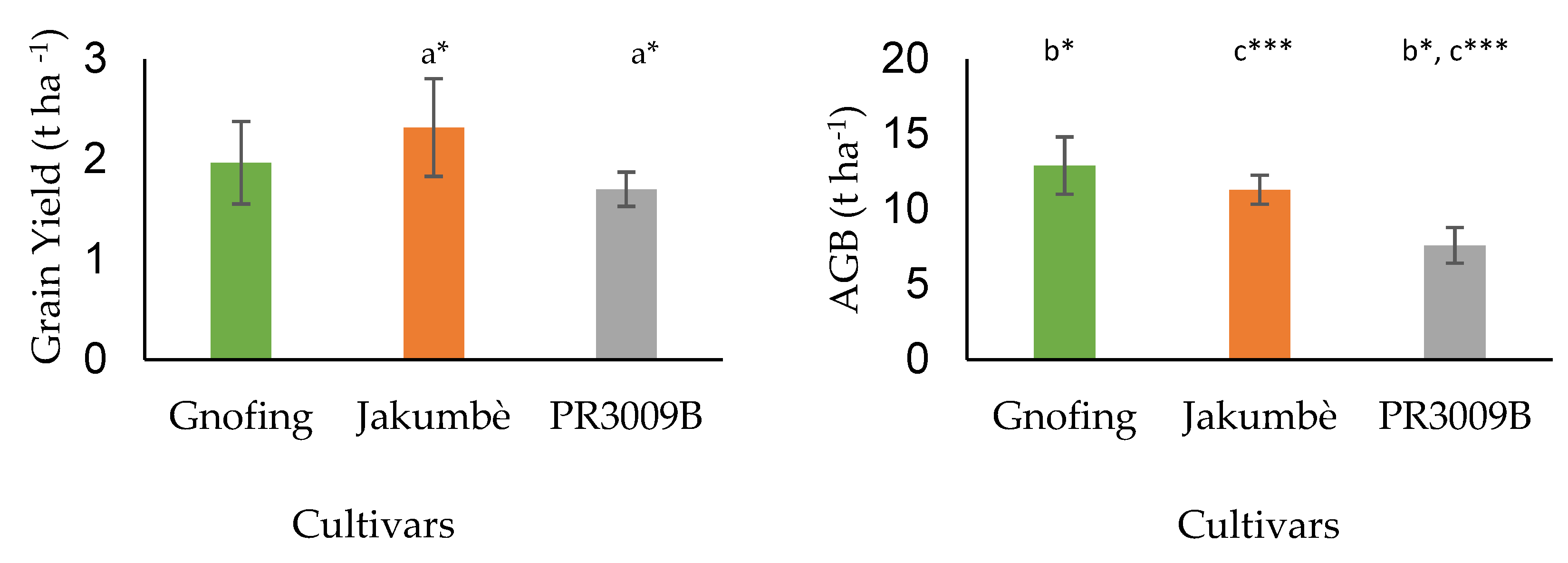
| Depths (cm) | Clay (%) | Silt (%) | Sand (%) | Bulk Density (g cm−3) | pH | C (g kg−1) | N (g kg−1) | P (mg kg−1) |
|---|---|---|---|---|---|---|---|---|
| 0–20 | 45.2 | 16.7 | 36 | 1.23 | 6.53 | 0.52 | 0.04 | ∅ |
| 20–40 | 54.20 | 15.70 | 29.20 | 1.36 | 6.19 | 0.34 | 0.03 | ∅ |
| 40–60 | 47.5 | 15.1 | 29.1 | 1.28 | 7.14 | 0.28 | 0.02 | 0.76 |
| 60–80 | 46.6 | 18.2 | 34.1 | 1.07 | 7.61 | 0.33 | 0.03 | 0.36 |
| 80–100 | 46.2 | 18 | 35.1 | 1.31 | 7.75 | 0.26 | 0.02 | 3.89 |
| 100–120 | 46.4 | 19.3 | 33.2 | 1.54 | 7.91 | 0.19 | 0.02 | ∅ |
| 180–200 | 42.2 | 20.1 | 35.5 | 1.36 | 8.14 | 0.20 | 0.02 | 0.41 |
| Grain Yield (t ha−1) | AGB Yield (t ha−1) | Canopy Height (cm) | ||||
|---|---|---|---|---|---|---|
| NI | I | NI | I | NI | I | |
| “Gnofing” | 2.13 ± 0.36 | 1.80 ± 0.46 | 14.65 a ± 0.18 | 11.21 b ± 0.06 | 439.00 ± 45.00 | 413.00 ± 11.62 |
| “Jakumbè” | 2.15 ± 0.62 | 2.48 ± 0.62 | 10.87 ± 0.66 | 11.94 ± 1.22 | 433.00 ± 21.11 | 412.50 ± 23.59 |
| “PR3009B” | 1.62 ± 0.02 | 1.78 ± 0.02 | 6.86 ± 0.84 | 8.70 ± 0.39 | 271.42 ± 30.35 | 274.83 ± 36.62 |
© 2020 by the authors. Licensee MDPI, Basel, Switzerland. This article is an open access article distributed under the terms and conditions of the Creative Commons Attribution (CC BY) license (http://creativecommons.org/licenses/by/4.0/).
Share and Cite
Müller, M.; Dembélé, S.; Zougmoré, R.B.; Gaiser, T.; Partey, S.T. Performance of Three Sorghum Cultivars under Excessive Rainfall and Waterlogged Conditions in the Sudano-Sahelian Zone of West Africa: A Case Study at the Climate-Smart Village of Cinzana in Mali. Water 2020, 12, 2655. https://doi.org/10.3390/w12102655
Müller M, Dembélé S, Zougmoré RB, Gaiser T, Partey ST. Performance of Three Sorghum Cultivars under Excessive Rainfall and Waterlogged Conditions in the Sudano-Sahelian Zone of West Africa: A Case Study at the Climate-Smart Village of Cinzana in Mali. Water. 2020; 12(10):2655. https://doi.org/10.3390/w12102655
Chicago/Turabian StyleMüller, Manuel, Siaka Dembélé, Robert B. Zougmoré, Thomas Gaiser, and Samuel T. Partey. 2020. "Performance of Three Sorghum Cultivars under Excessive Rainfall and Waterlogged Conditions in the Sudano-Sahelian Zone of West Africa: A Case Study at the Climate-Smart Village of Cinzana in Mali" Water 12, no. 10: 2655. https://doi.org/10.3390/w12102655
APA StyleMüller, M., Dembélé, S., Zougmoré, R. B., Gaiser, T., & Partey, S. T. (2020). Performance of Three Sorghum Cultivars under Excessive Rainfall and Waterlogged Conditions in the Sudano-Sahelian Zone of West Africa: A Case Study at the Climate-Smart Village of Cinzana in Mali. Water, 12(10), 2655. https://doi.org/10.3390/w12102655






